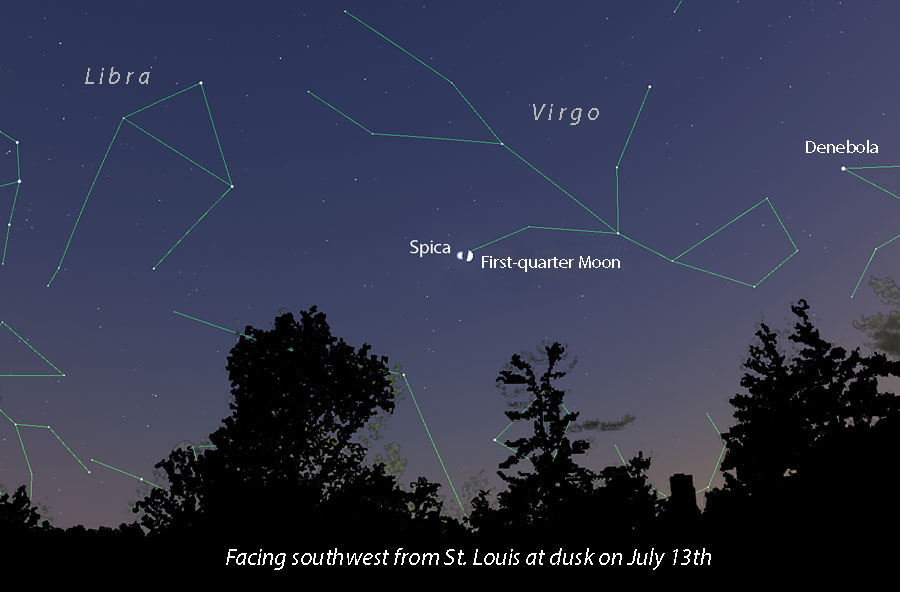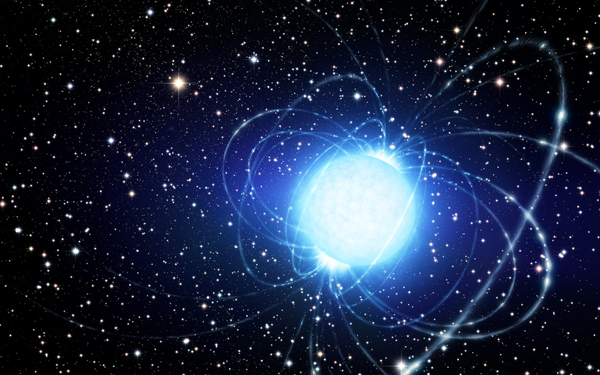Stellarium with additions by Bob King
Lunar occultations are commonplace but often involve fainter, telescopic stars. This month we have a wonderful exception. On the night of July 13th, the Moon will cover Virgo’s brightest star Spica for much of North and Central America. Sometimes moonlight overwhelms or diminishes the impact of an occultation. Thankfully not this time because the Moon will be in first-quarter phase. Through a small telescope you’ll still be able to detect the outline of the earthlit western limb and anticipate the breathtaking moment of Spica’s disappearance. Even binoculars will show the star blink out though they may lack sufficient light-gathering power to reveal the limb.
Like a traffic circle without exits the Moon’s path is restricted to the ecliptic zone. Round and round the circle it goes, completing one revolution of the sky approximately every month. Because the Moon’s orbit is tipped 5.1° relative to the plane of Earth’s orbit — which defines the ecliptic — the Moon weaves above and below the plane, so its path over time more resembles a ribbon than a circle. Within that band are four 1st-magnitude stars — Antares, Aldebaran, Regulus, and Spica — that occasionally find themselves squarely in the Moon’s path. When it covers one of them, we get to witness a relatively tiny, orbiting ball of rock temporarily “remove” a star several thousand times its size from the sky.
M. Tanikawa
Spica will disappear with surprising suddenness at the Moon’s dark limb and reappear later with equal abruptness at the opposite bright limb. While the star appears single it’s actually a spectroscopic binary system comprising a blue giant primary almost 8 times the Sun’s diameter and a secondary sun about half that size. Although it’s theoretically possible to use video to record a stepwise dimming of Spica’s light as each star is occulted in turn, the challenge is great. They’re separated by a third of the average distance between Mercury and the Sun and are 250 light-years away, factors that effectively shrink the duo to a point too small to resolve in even the largest instruments.
Most stellar occultations occur suddenly for that reason. It takes almost no time for a moving object to cover a point. When combined with the lack of a lunar atmosphere — which would otherwise dim the star upon approach — and the Moon’s speed at the time (3,500 kilometers per hour), it’s easy to see why Spica will vanish in a flash.

Map by Bob King using Stellarium
Observers in the eastern states will see Spica disappear at the Moon’s dark limb around 10:30–11 p.m. local time. In the Midwest, the occultation occurs in mid-twilight about 10 o’clock, while across the Mountain Time Zone it happens shortly after sunset. Although the Sun will still be shining from cities along the Pacific Coast, as long as the sky is blue and haze-free, Spica should be visible in daylight through a small telescope. Point your instrument at the Moon and look for a pinpoint of light just to its east. With the dark limb invisible, Spica will disappear in a blue sky at occultation time.
For the scoop on both reappearance and disappearance times for your city, pay a visit to the International Occultation Timing Organization’s (IOTA) Spica occultation page. Times there are in UT or Universal Time. To convert to Eastern Daylight Time, subtract 4 hours and move the date back one day. For CDT, subtract 5 hours; 6 hours for MDT; and 7 hours for PDT. For example, Spica will disappear at 3:12 UT on July 14th from Lansing, Michigan. Subtract 4 hours (Eastern Time Zone) to get 11:12 p.m. local time on July 13th.
The Spica occultation season began on June 16th when the Moon covered the star for observers in Eastern Europe and northwestern Asia. Many more will follow until the current series ends on November 17, 2025. After that the rambling Moon won’t pester the pair again until 2031.
Comet 13P/Olbers update

Bob King
Comet 13P/Olbers, which I reported on here last month, has been trending a little brighter than original expectations. As July opens it glows around magnitude 6.5 and is easily visible in 50-mm binoculars in late twilight. On June 29th in my 10×50s I noted a fuzzy coma about 5′ across with a brighter, more compact center and a wisp of a tail pointing upwards to the northeast. In my 15-inch (38 cm) Dob, 13P’s bright head and half-degree tail made a beautiful sight.

Stellarium with additions by Bob King
As the comet crosses from Lynx into Ursa Major it skirts the Three Leaps of the Gazelle asterism — three pairs of stars that represent the creature’s hoof-marks in pond mud. Highly anticipated Comet Tsuchinshan-ATLAS (C/2023 A3) has stalled at around magnitude 10 even as its tail has increased in length. It’s located in southern Leo very low in the southwestern sky at nightfall. Mid-northern latitude observers only have a week or two left before the comet disappears in the solar glow, not to return to view until late September at dawn.




